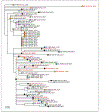Investigation of a Cluster of Sphingomonas koreensis Infections
- PMID: 30586509
- PMCID: PMC6322212
- DOI: 10.1056/NEJMoa1803238
Investigation of a Cluster of Sphingomonas koreensis Infections
Abstract
Background: Plumbing systems are an infrequent but known reservoir for opportunistic microbial pathogens that can infect hospitalized patients. In 2016, a cluster of clinical sphingomonas infections prompted an investigation.
Methods: We performed whole-genome DNA sequencing on clinical isolates of multidrug-resistant Sphingomonas koreensis identified from 2006 through 2016 at the National Institutes of Health (NIH) Clinical Center. We cultured S. koreensis from the sinks in patient rooms and performed both whole-genome and shotgun metagenomic sequencing to identify a reservoir within the infrastructure of the hospital. These isolates were compared with clinical and environmental S. koreensis isolates obtained from other institutions.
Results: The investigation showed that two isolates of S. koreensis obtained from the six patients identified in the 2016 cluster were unrelated, but four isolates shared more than 99.92% genetic similarity and were resistant to multiple antibiotic agents. Retrospective analysis of banked clinical isolates of sphingomonas from the NIH Clinical Center revealed the intermittent recovery of a clonal strain over the past decade. Unique single-nucleotide variants identified in strains of S. koreensis elucidated the existence of a reservoir in the hospital plumbing. Clinical S. koreensis isolates from other facilities were genetically distinct from the NIH isolates. Hospital remediation strategies were guided by results of microbiologic culturing and fine-scale genomic analyses.
Conclusions: This genomic and epidemiologic investigation suggests that S. koreensis is an opportunistic human pathogen that both persisted in the NIH Clinical Center infrastructure across time and space and caused health care-associated infections. (Funded by the NIH Intramural Research Programs.).
Figures




References
-
- Antibiotic/antimicrobial resistance: biggest threats and data. Atlanta: Centers for Disease Control and Prevention, 2013. (http://www.cdc.gov/drugresistance/threat-report-2013).
-
- Requirement to reduce Legionella risk in healthcare facility water systems to prevent cases and outbreaks of legionnaires’ disease (LD). Baltimore: Centers for Medicare & Medicaid Services, June 2, 2017. (https://www.cms.gov/Medicare/Provider-Enrollment-and-Certification/Surve...).
-
- Conger NG, O’Connell RJ, Laurel VL, et al. Mycobacterium simae outbreak associated with a hospital water supply. Infect Control Hosp Epidemiol 2004;25:1050–5. - PubMed
-
- Osawa K, Shigemura K, Abe Y, et al. A case of nosocomial Legionella pneumonia associated with a contaminated hospital cooling tower. J Infect Chemother 2014;20:68–70. - PubMed
Publication types
MeSH terms
Substances
Grants and funding
LinkOut - more resources
Full Text Sources
Miscellaneous
